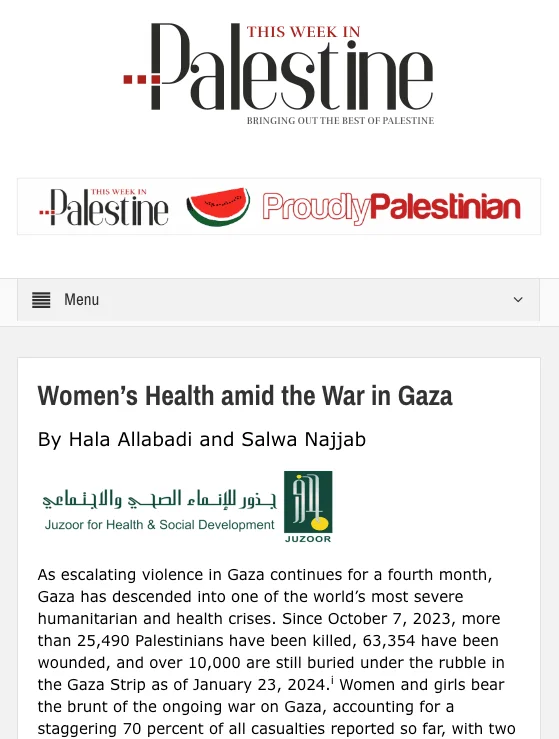Article: Women’s Health amid the War in Gaza
THIS WEEK IN PALESTINE
Women’s Health amid the War in Gaza
By Hala Allabadi and Salwa Najjab
 As escalating violence in Gaza continues for a fourth month, Gaza has descended into one of the world’s most severe humanitarian and health crises. Since October 7, 2023, more than 25,490 Palestinians have been killed, 63,354 have been wounded, and over 10,000 are still buried under the rubble in the Gaza Strip as of January 23, 2024.i Women and girls bear the brunt of the ongoing war on Gaza, accounting for a staggering 70 percent of all casualties reported so far, with two mothers killed every hour since atrocities erupted more than 100 days ago. More than 1.9 million people, 85 percent of the total population of Gaza have been displaced,ii including approximately one million women and girls. As a result, women and girls are seeking refuge in overcrowded shelters that lack essential provisions, such as food, water, healthcare, safety, and privacy, heightening protection risks.iii Furthermore, women are having to make impossible decisions regarding whether to evacuate, how and when they will do so, and where to go, all while grappling with fears of encountering attacks and harassment while on the move. It has been reported that women have also been exposed to violence and harassment by Israeli soldiers while they have been continuously on the move throughout the war. iv
As escalating violence in Gaza continues for a fourth month, Gaza has descended into one of the world’s most severe humanitarian and health crises. Since October 7, 2023, more than 25,490 Palestinians have been killed, 63,354 have been wounded, and over 10,000 are still buried under the rubble in the Gaza Strip as of January 23, 2024.i Women and girls bear the brunt of the ongoing war on Gaza, accounting for a staggering 70 percent of all casualties reported so far, with two mothers killed every hour since atrocities erupted more than 100 days ago. More than 1.9 million people, 85 percent of the total population of Gaza have been displaced,ii including approximately one million women and girls. As a result, women and girls are seeking refuge in overcrowded shelters that lack essential provisions, such as food, water, healthcare, safety, and privacy, heightening protection risks.iii Furthermore, women are having to make impossible decisions regarding whether to evacuate, how and when they will do so, and where to go, all while grappling with fears of encountering attacks and harassment while on the move. It has been reported that women have also been exposed to violence and harassment by Israeli soldiers while they have been continuously on the move throughout the war. iv
According to UN Women, estimates show that at least 3,000 women may have become widows and heads of households, and at least 10,000 children may now be fatherless.v Women increasingly fear that, in light of food shortages, school closures, and loss of educational opportunities, families will resort to desperate coping mechanisms, including early marriage, especially given the high number of young girls who have lost one or both parents.vi Currently, women and girls are seeking refuge in overcrowded shelters that lack essential provisions, such as food, water, and privacy, heightening protection risks.vii The significant largely displaced population of women and girls, and new female-headed households, have unique and urgent needs and vulnerabilities that must be recognized and addressed.
Mental health
An escalating mental health crisis in the enclave is vastly overshadowed by the scale of death and destruction caused by more than three months of bombardment. Experts believe that the psychological damage may prove one of the war’s most lasting legacies. Mothers living in Gaza under these indescribable conditions are currently experiencing multiple losses and deteriorating living conditions, including increasing poverty, displacement (in most cases several times), terror, harassment, high stress in managing everyday life with insufficient resources, and a sense of hopelessness. The ongoing exposure to the horrors of this war have exacerbated the mental health needs of women as they navigate anxiety, severe depression, and other forms of mental illness.viii For pregnant women, the situation is doubled, as war trauma is also associated with increased obstetric complications in pregnancy, including miscarriage.ix
Food insecurity
For the first time in Gaza’s history, people are facing the looming threat of starvation and famine every day due to unceasing hostilities combined with restricted humanitarian access.x With food insecurity reaching unprecedented levels, women and girls are anticipated to bear the brunt of the situation, given that they frequently prioritize others over themselves when access to food is limited. Similarly, women who head households face security and protection risks while attempting to access food distribution points, making their families particularly vulnerable to severe food insecurity.xi Pregnant and lactating women are particularly at risk of undernutrition or malnutrition, heightening the risk of birth defects or death. xii
